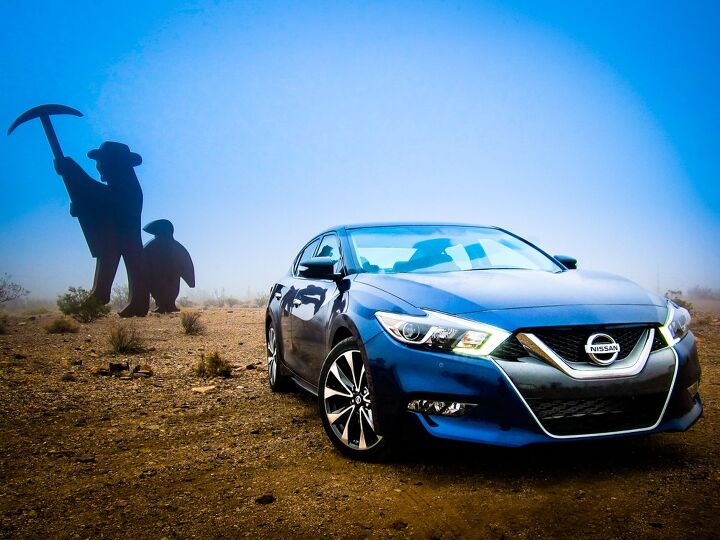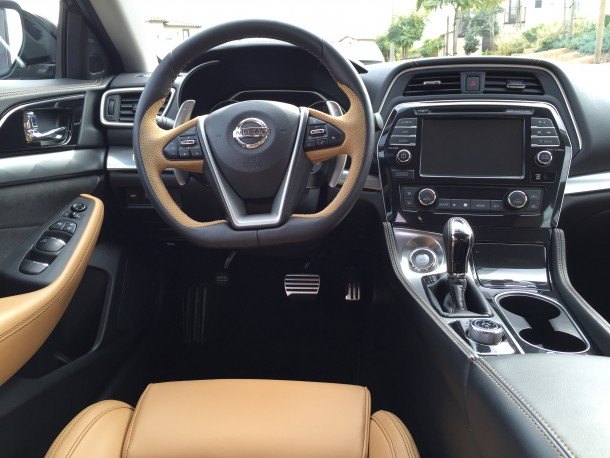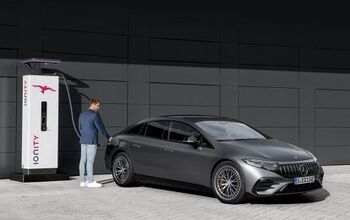2016 Nissan Maxima SR Review - The Impurist's Sports Sedan

2016 Nissan Maxima SR
Like cockroaches scattering in the light, Americans are fleeing sedans for the upright comfort and wagon-like space of crossovers.
The full-size sedan segment has recently been hit hard, Maxima included. Since 2012, the auto market has expanded 20 percent, while full-size sedan sales have contracted 14 percent. Based on an aging design and the entrance of Korean rivals, the Maxima’s 12-percent market share in 2012 dwindled to eight percent in 2015.
There is a fair chance no more than six people will read this review, and five of those readers will be future doctoral students deconstructing the final days of the sedan. Does that mean no matter how good the Maxima is — or could be — it’s doomed to fail?
The Maxima, now in its eighth generation, was introduced in 1981. In 1989, it graduated from compact to mid-size, coinciding with the introduction of its 4-Door Sports Car (4DSC) branding. The 2015 redesign returns the car to a competitive footing and builds on its sporting legacy. Overall length is stretched 2.2 inches, mass reduced 82 pounds, and torsional rigidity increased 25 percent. The familiar 3.5-liter V-6 has been goosed to a more psychologically alluring 300 horsepower, though it lacks direct injection. The new car also includes some 4DSC Easter Eggs, if not the real BMW-fighting DNA of the third to fifth generation cars (see The First Seven Generations of Maxima, Ranked).
Exterior
The car also benefits from continuing wheel inflation. The SR sports sharp 19-inch alloys on 40-series rubber. The 1.3-inch height reduction for 2015, along with its tight wheel gaps, gives this full-sizer an athletic stance. The rear end is inoffensive. Nissan took some risk when it gave the Maxima its aggressive presence, but it paid off. Whether you like the Maxima’s exterior or not, you won’t mistake it for another full-size sedan.
Interior
The Ascot leather shod seats with quilted Alcantara inserts are a comfortable and attractive premium touch, though they require elevating to the SR. The Alcantara inlays on the steering wheel are an attractive element on an already handsome wheel, but my 4,000 mile press car was already showing wear on the deluxe material. Maxima drivers get a comfortable 10-way power heated and cooled perch, besting most of the competitors’ 8-way non-cooled units. Together, the driving position offers a visually cohesive, well appointed place to be.
These cars will ferry everything from kids to octogenarians, so rear seat access and comfort are important. And it’s in the rear where it becomes clear why the EPA rates the Maxima as a mid-size. This car is the shortest in its peer group and rear-seat legroom suffers, measuring one to five inches less than the competition. If you plan to haul kids under two, the NHTSA recommends a rear-facing car seat. You need to either be short or anticipate moving the front seats forward to accommodate young ones.
The sloping roof-line puts the Maxima at a rear headroom disadvantage, where it is roundly bested by the competition. Thankfully, Nissan did not succumb to the egregious stoop-inducing transgressions of the Mercedes CLA or BMW Gran Coupes, and access is satisfactory. The attractive Ascot leather with quilted Alcantara continues in the rear, where attractive details, such as liquid chrome accents, abound. The rear is far from punishing. My 6-foot-1-inch frame fit just fine in the outboard positions.
The Maxima features a 60/40 folding rear seat, opening into a 14.3 cubic foot trunk. The boot is wide and usable, but somewhat less spacious than the competition. The Maxima is the shortest overall in the segment by three to eight inches. Its trim dimensions carry through to the interior. By no means does it feel confined, but it’s still the smallest interior in its class at 99 cubic feet. The interior is a balanced execution of driver-centric sporting luxury, but if you are an Uber driver, this is probably not your car.
Technology
The infotainment system is centered on an 8-inch screen with touch, voice, rotary, and steering wheel mounted controls. I gravitated toward the dial, thanks to its relaxed location aft of the shifter where one’s hand naturally comes to rest. Navigation is standard across trims, as are hands-free text messaging and a rear-view camera. Voice navigation inputs are rapidly recognized; not once did I need to repeat an address. And transitioning calls from phone to Bluetooth was a refreshingly rapid, dead-spot free exercise.
The 11-speaker Bose audio system delivers a full sound devoid of the shrill highs and non-existent lows of lesser audio systems. The sound quality is above average for the segment and its ease of use across radio, satellite, USB, and Bluetooth is excellent. The Maxima offers branded audio integration with two to five more speakers than the competition. For audiophiles shopping this segment, this may be your car.
The 2015 Maxima update enabled Nissan to plug in all its available safety and security technologies. The car offers the de rigueur Vehicle Dynamic Control and traction control from the base S up. Moving to the SL gets you a slick blind-spot warning system, rear cross traffic alert, Predictive Forward Collision Warning, and Forward Emergency Braking. Most of these systems went untested, but IIHS destroyed several Maximas and made it a Top Safety Pick.
Winning the award for the most delightfully useful, easy-to-operate system is Intelligent Cruise Control (standard from the SL up). When activated, the system cruises at the speed selected. When approaching slower traffic, it matches their speed. In Sport Mode, Active Sound Enhancement plumbs a pleasantly sporting indication of speed into the cabin. However, on the freeway where cruise control is most likely to be used and Sport Mode is not, this well insulated car does not conspicuously communicate velocity. Thus, when following a slower vehicle using cruise control, you may not realize you have shed several miles per hour. Be that as it may, you want Intelligent Cruise Control in your next car. It works in more densely spaced traffic than standard systems and reduces driver fatigue.
Drivetrain
The drivetrain is sector competitive, falling a few horsepower below Impala and Genesis, and above Avalon. The story is similar for torque, though the Maxima peaks lower in the rev range, aiding in off-the line acceleration. According to Motor Trend, the Maxima is a half second faster to 60 than both Impala and Avalon.
Nissan has been working with CVTs for over 20 years, so the Xtronic CVT in the Maxima is a mature unit. For gear-heads, Nissan tuned the CVT with what it terms D-Step shifting logic. This is intended to simulate a conventional automatic, with rapid shifts as well as the ability to hold revs through high-G corners, enabling more rapid exits. For those who can discern the difference between this and a traditional automatic, you may be disappointed. For the remaining 99 percent who are unaware of the technical aspects of corner entry and exit, the Xtronic CVT works just fine.
The CVT, in conjunction with the car’s relatively low mass, delivers good fuel economy. The Maxima is rated by the EPA at 22/30/25 (city/highway/combined), edging out Genesis, Avalon, and Impala at 22 to 24 mpg combined. The Maxima SR tester delivered 27.8 miles per gallon during a heavy footed, highway-intensive 829 mile test-cycle.
Drive
The car is suspended on a strut/coil spring arrangement at the front and an independent multi-link double wishbone in back. The SR gets more aggressive suspension damper tuning, a larger front stabilizer bar, and a chassis damper to quiet the NVH that comes with its more aggressive setup. In an effort to lower the SR’s center of gravity, Nissan deleted the dual panel panoramic moonroof. However, its omission is confusing, as consumers looking for a hard-core performance sedan will already have been turned off by the front-wheel drive and CVT. Regardless, if you want the most sporting Maxima, you won’t be enjoying the stars from above.
In a land of SUVs, the Maxima drives small and is as easy to place on the road as it is in a parking lot. Steering inputs stimulate confidence and body roll is consistently held in check across a variety of road surfaces. The car was at home cruising Interstate 15 from San Diego to Las Vegas. Its 10-way powered comfort, easy to operate intelligent cruise control, and intuitive infotainment system make it a good place to oscillate between engaged driving and the distraction of a good audiobook.
The return route from Las Vegas to San Diego went through Death Valley. The area is known to forego rain for an entire year. Extremes aside, the park averages 0.39 inches of the wet stuff each January. This year, it recorded January’s total on the day I drove through. This is flash-flood country, where the ground does not possess good water absorbing qualities. Within minutes there was standing water on the road, later deteriorating to running water.
The conditions enabled an exploration of the car’s limits in the wet. Descending the gently sloping alluvial fan on Beatty Road onto the valley floor was a joy. Long sweeping transitions, combined with lengthy sight-lines and limited traffic, safely accommodate high speeds. If you had a five-speed manual and were in a hurry, this would be 3rd, 4th, and 5th gear country. It was an ideal route for the Maxima. Sport Mode was engaged, paddle shifters actuated, and brakes authoritatively employed. The car is eager to attack curves at speeds well above posted advisory signs.
But water eventually got the best of the Maxima’s 245/40R19 all-season Goodyears. There were moments of lost adhesion, but the car was generally planted, its steering communicative, brake fade non-existent, and driving position comfortable. The Maxima is somewhat less composed when negotiating tight canyons, but that’s what the 370Z and GT-R are for.
The Maxima is as sporty as one can get in a full size, front-wheel-drive sedan. But, best of all, its sporting tendencies do not require compromise during less spirited operation.
Pricing
Shoppers seeking wide open spaces in their full-size sedan may want to look elsewhere. Likewise, this car is not ideal for the driver seeking anonymity — Maxima is an extrovert in a conservative segment. But with its one-year-old redesign, the Maxima offers a compelling mix of sector leading technology and a top safety rating, along with an easy to live with driver-first philosophy.
If the bright lights have not sent you scurrying for a crossover and you need some fun in your next full-size sedan, put the Maxima on your shopping list.

Twenty year auto industry professional. Currently CEO at Turbo International, the premier American manufacturer of OEM replacement turbochargers for the global aftermarket.
More by Seth Parks
Latest Car Reviews
Read moreLatest Product Reviews
Read moreRecent Comments
- Akila Hello Everyone, I found your blog very informative. If you want to know more about [url=
- Michael Gallagher I agree to a certain extent but I go back to the car SUV transition. People began to buy SUVs because they were supposedly safer because of their larger size when pitted against a regular car. As more SUVs crowded the road that safety advantage began to dwindle as it became more likely to hit an equally sized SUV. Now there is no safety advantage at all.
- Probert The new EV9 is even bigger - a true monument of a personal transportation device. Not my thing, but credit where credit is due - impressive. The interior is bigger than my house and much nicer with 2 rows of lounge seats and 3rd for the plebes. 0-60 in 4.5 seconds, around 300miles of range, and an e-mpg of 80 (90 for the 2wd). What a world.
- Ajla "Like showroom" is a lame description but he seems negotiable on the price and at least from what the two pictures show I've dealt with worse. But, I'm not interested in something with the Devil's configuration.
- Tassos Jong-iL I really like the C-Class, it reminds me of some trips to Russia to visit Dear Friend VladdyPoo.
















































































Comments
Join the conversation
Sixty percent of the engine parts were replaced for a 3.45% increase in horsepower, and 0% increase in torgue? Law of diminishing returns strikes again?
Ya know, it's really not a bad car. The styling is attractive, it's got all the features you could want in what is essentially a family sedan, and it's quick. The top-of-the-line Platinum model (MSRP around $41,095) can be had for close to $33k at dealers near me. That's pretty excellent. $33,000 for a car that can more than keep up with traffic and provides you with all of the bells and whistles? Not bad at all.